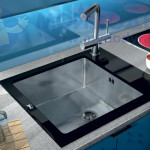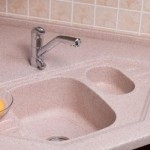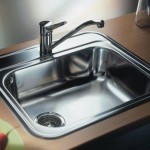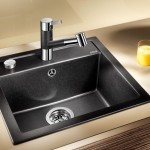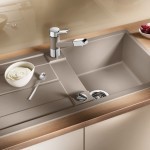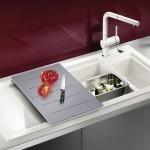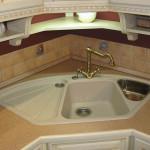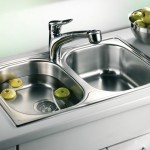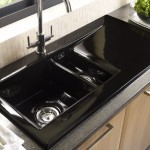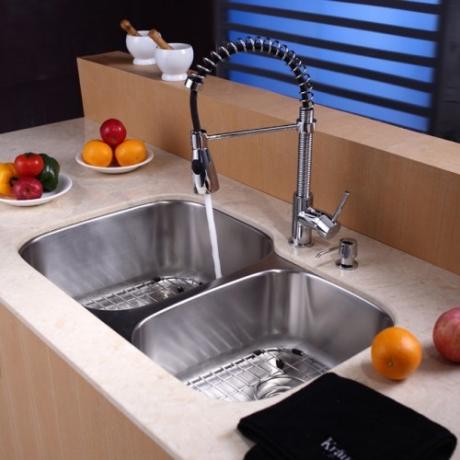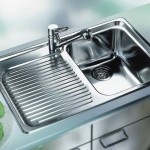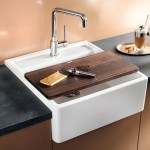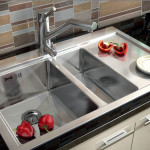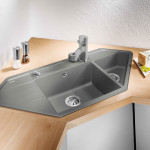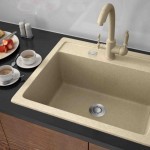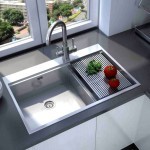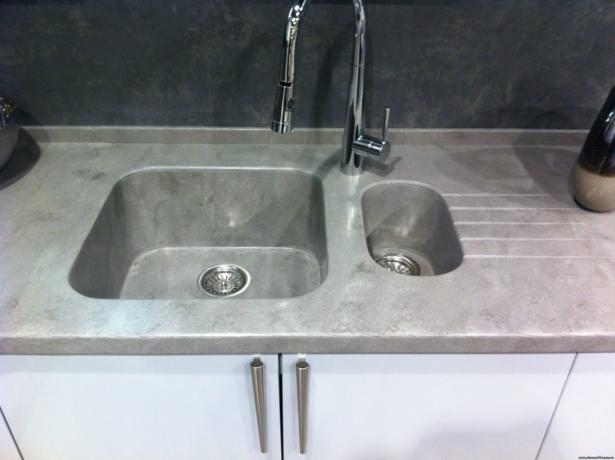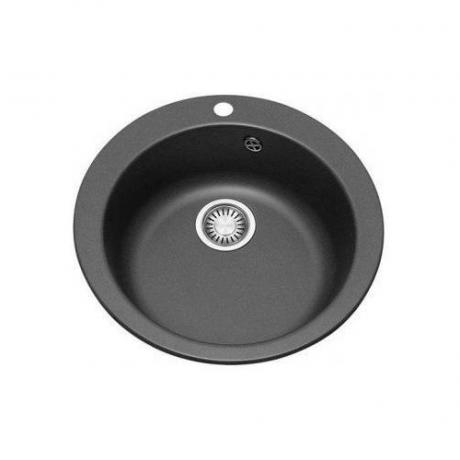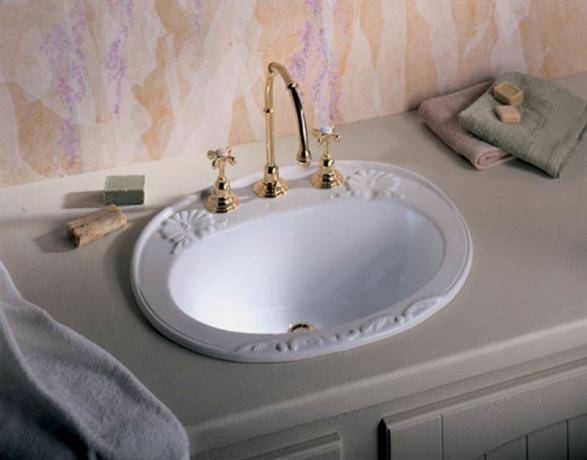Content
-
1 Varieties of shells
- 1.1 General differences
- 1.2 Metal sinks
- 1.3 Ceramic sinks
- 1.4 Composite artificial stone sinks
-
2 Installation types of kitchen sinks
- 2.1 Integrated sinks
- 2.2 Flush sinks
- 2.3 Overhead sinks
- 3 Conclusion
Kitchen sinks are designed not only and not so much for washing hands as for washing metal and ceramic dishes, porcelain, glass, meat products and vegetables, fruits and many others items.
Also, the kitchen sink is used for defrosting, thawing and soaking food, and during the holidays it turns into a real battlefield, where an incredible amount of dishes accumulates, washing and drying takes place, and all this in blitz mode. Therefore, it is important to understand how to choose a sink for the kitchen, so that later it will become a faithful assistant in a difficult household.

Kitchen sinks come in many varieties and can serve many functions.
Varieties of shells
General differences

Blanco metal washbasin with ergonomic design.
Before deciding which sink to choose, you need to know what sinks and sinks are for the kitchen.
So, let's list the main types:
- Metal sinks for kitchen: cast iron and steel sink, sink for kitchen made of stainless steel, alloyed with nickel or chrome, welded and stamped;
- Ceramic sinks and sinks for the kitchen: porcelain and earthenware, made by other technologies using various recipe schemes and firing procedures;
- Stone sinks: made on the basis of natural marble and granite, composite and bulk.
Also, the kitchen sink may have differences in shape:
- Round;
- Rectangular;
- Triangular;
- Oval;
- Square;
- Single;
- Double;
- Small;
- Large;
- With and without dryer.
In addition, the kitchen sink may differ in the way of installation and location.
There are such varieties:
- Integrated or built-in sinks;
- Mortise kitchen sinks;
- Overhead sink;
- Island sink;
- Corner sink;
- Sink by the window in the kitchen;
- Classic sink.
Important! If you want to change the location of the sink, remember: moving the sink in the kitchen is not easy and not cheap, since it will require work on laying water supply and sewerage pipes.
Metal sinks

Although enamelled kitchen sinks are considered yesterday, they are still used by leading manufacturers of sanitary ware.
Steel and cast iron kitchen sinks are one of the oldest and most common models in our country, which are gradually becoming obsolete. Since cast iron and steel actively rust, these sinks are covered with enamel. But the enamel tends to chip and crack, turn yellow and react with aggressive chemistry.

Nickel alloy stainless steel sinks have become a classic in modern kitchens.
Undoubtedly a better quality and progressive sink for the kitchen is a stainless steel sinkplated with chrome or nickel. These products are relatively cheap and of good quality. Such sinks do not corrode, do not change color, they are not afraid of chips and scratches. In terms of price / quality ratio, these sinks claim to be the leader.
Benefits of metal sinks:
- Low cost;
- Simple installation;
- High strength.
Disadvantages:
- High noise level;
- Enamel sinks wear out quickly and begin to rust;
- Monotonous in terms of design;
- Welded sinks can leak water over time.
Despite many disadvantages, metal sinks continue to be actively produced by many leading companies. For example, blanco kitchen sinks are a fine example of engineering and design, combining functionality, elegance in shapes and finishes with high quality workmanship. In any case, it is up to the consumer to decide which sink is better - metal or other.
Advice! Pay attention to the drain hole: the optimal drain for the kitchen sink is 38 mm in diameter.
Ceramic sinks

Porcelain sinks look expensive and sophisticated.
For those who want a certain sophistication and chic when creating a kitchen interior, you should pay attention to ceramic sinks and sinks. The ceramics used for the production of kitchen sanitary ware have many types, but the main ones are porcelain and earthenware..
Faience is made from white clay with the addition of quartz components and kaolin. Firing is carried out at a temperature of 1100 - 1200 ° C. Porcelain is made from the same raw materials, but according to a different recipe and firing technology. In general, porcelain is somewhat stronger and of better quality than faience.
Faience and porcelain absorb moisture and odors, so the sinks are covered with special glaze or enamel. The coating can be transparent, white or colored glass.

Ceramic sink can be a decoration of the kitchen.
The advantages of ceramic sanitary ware:
- Exquisite expensive appearance;
- High strength of the material;
- High wear resistance;
- Withstands high temperatures;
- Easy to clean and not afraid of chemicals;
- Durability.
Disadvantages:
- High price;
- Low fracture strength, may break when a heavy object falls;
- Requires care;
- Chips may form.
Advice! When choosing a sink, do not buy sinks whose dimensions are less than 40 cm, as large and even medium-sized dishes will not fit into such a sink.
Composite artificial stone sinks

Stone sinks look great and are very comfortable.
A relatively young material - artificial stone - is becoming more and more popular. It is made from stone chips, quartz sand and polymer binder, most often acrylic. Natural crumb gives products made of this material a special texture and color. Also, dyes and pigments are added to the mixture, achieving a wide variety of colors.
There are two main types of composite stone - corian and polycarbonate. The first is considered an almost eternal material, resistant to scratches, chips, temperature and chemicals. Polycarbonate is also very practical, it can withstand temperatures up to 150 ° C and aggressive detergents without any problems.

Blanco Modex M60 overhead sink for kitchen made of composite stone.
To the benefits stone sinks for kitchen relate:
- High strength;
- Possibility of seamless connection with the table top;
- Resistant to high temperatures;
- Lack of biological, electrochemical and chemical corrosion;
- High wear resistance;
- The ability to create all kinds of shapes and sizes of shells;
- Durability;
- Not afraid of aggressive chemicals and detergents;
- Not afraid of scratches and chips;
- Withstands high mechanical loads;
- Looks nice and expensive.
But there are also disadvantages:
- High price;
- Large mass;
- The complexity of the installation.
Installation types of kitchen sinks
Integrated sinks
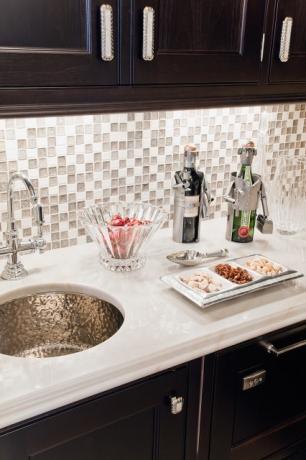
The small integrated sink looks great in the kitchen.
Integrated sinks seem to be integrated into the worktop and form one whole with it. Only professional plumbers and manufacturers of kitchen sets know how to assemble such a sink.
The most difficult option is under-table installation, in which the sink is installed below the table top level:

The under-table setting allows you to showcase the beauty of the stone on a cut.
An integrated installation requires a precise cutout in the worktop, which can only be made on a coordinate milling machine or other similar equipment.
An integrated plant has many advantages:
- Ease of use;
- Hygiene;
- The beauty;
- Easy to care for.
Flush sinks

The inset sink is often found in modern kitchen interiors.
This method of installation does not require such a precise cut-out in the countertop, so that an ordinary craftsman or a beginner can handle it.
Such sinks can be installed under a worktop made of any material: stone, MDF, solid wood, chipboard, plastic or steel. Unlike overhead sinks, the cabinet under the sink is not required to have strict dimensions, therefore the cut-in sinks provide a much wider selection of furniture: a cabinet, a table and a cabinet will do..
The advantages of inset sinks include:
- Cheap installation;
- Ease of use;
- Hygiene and easy maintenance;
- Variability in the choice of furniture;
- Suitable for various types of worktops.
Advice! Pay attention to the double kitchen sinks: they are functional and practical, they allow you to wash and defrost at the same time, as well as wash vegetables and dishes in separate sinks.
Overhead sinks

The overhead sink is the most common model.
As you might guess from the name, such a sink is superimposed on a cabinet or cabinet, as if replacing its countertop.. This is the simplest and therefore the most common type of kitchen sink installation.
To install it, no special skills or special talents are required; any man can handle such work. Connecting to water supply and sewerage also does not cause problems.
The disadvantage is that the view is not particularly beautiful from an aesthetic point of view, resembling an operating room or a catering establishment.
At the same time, there are certain advantages:
- Easy installation;
- Low price;
- A light weight;
- Can be replaced at any time without much difficulty.
Advice! Try to position the sink so that there is free access to the space below it. This can be critical when you have to clean a siphon or punch a blockage in a pipe.
Conclusion
The choice of kitchen furniture, and especially plumbing, should be approached wisely.
The comfort, convenience and functionality of your kitchen will depend on this choice, and hence the mood of its owner, and this is already a matter of survival. Choose high-quality plumbing, think over the kitchen equipment in the complex, do not regret and do not save on things on which the quality of your life depends, and you will be happy!
Gallery

